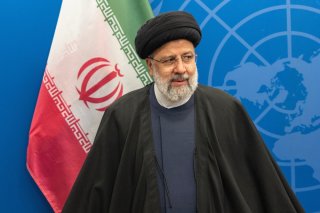Iran Needs A New Round of Sanctions
Tehran’s would-be regime-changers for the Middle East are themselves vulnerable to regime change.
In the wake of the devastating surprise attacks on Pearl Harbor on December 7, 1941, what President Franklin Roosevelt famously called “a date that will live in infamy,” Washington lawmakers and military officers wondered why there wasn’t some kind of warning.
Indeed, there were hints and portents, but no one official had put the puzzle together that a Japanese air and naval attack on Hawaii was imminent.
Similarly, after the September 11 attacks, a special commission found that “information silos” kept agencies from connecting the dots and recognizing Al Qaeda as a mortal threat.
Indeed, as late as 1995, the State Department had dismissed Osama bin Laden as a financier, not a field marshal.
In Israel, the brutal and sudden nature of Hamas’s terrorist attack on Israel on October 7, 2023, has shocked Israel and upended its entire security conceptions. The most powerful military in the Middle East had not only completely underestimated the magnitude of the attack. The Israeli state had totally failed in its intelligence-gathering efforts due to hubris and the mistaken assumption that Hamas was a “contained” threat.
This time, there is a warning, which draws together myriad strings into a coherent pattern. It appears in a dry, strong report called the “Annual Threat Assessment of the U.S. Intelligence Community,” published on February 5 by the Director of National Intelligence. In its forty bullet-pointed pages, professionals from the three major U.S. Intelligence agencies, DNI, CIA, and FBI, soberly present a picture that should alarm policymakers and the public.
Its unspoken theme: The urgent need for U.S. leadership as its enemies align together, strike at allies in Israel and Ukraine and attack U.S. ships in the Red Sea while menacing Taiwan and South Korea.
Iran is directly challenging the American order by using its proxies, Hamas and Hezbollah, to fire rockets into Israel and kidnap Israeli and U.S. citizens.
Meanwhile, Iran’s proxy force in Yemen, the various Houthi factions, attacked U.S. Navy warships at the direction of an Iranian spy ship. Iran is also building drones that Russia is using against Ukraine and missiles that can reach America’s NATO allies.
Iran’s ballistic missile program, the report notes, is already the largest in the Middle East. Iran has also partnered with China and Russia, an alignment sprawling across much of the Eurasian landmass. Most ominously, the report finds that Iran remains committed to its decade-long effort to develop surrogate networks to attack sites inside the United States.
Finally, Iran is continuing to target current and former U.S. officials in retaliation for a U.S. missile strike that killed Islamic Revolutionary Guard Corps Commander Qasem Soleimani in January 2020. Soleimani had a long history of coordinating murderous attacks and hostage-taking efforts by various terror groups against American and allied citizens.
The political will to isolate Iran with international sanctions and bans on arms sales seems to be weakening, especially among America’s European allies, who want to sell weapons to both NATO and Iran.
The Biden administration will have to corral European leaders, especially in Germany, France, and Sweden, and remind them that Ukraine and NATO need all the weapons that their arms makers can ship and that supplying Iran, which is already at war with the U.S., is contrary to the spirit of the NATO alliance.
Next, sanctions should be broadened to companies and countries that supply arms to either Iran or its proxies, the Lebanese Hezbollah, the Houthis, and the Iran-backed militias in Iraq and Syria. Sanctions should reflect the reality, the threat assessment notes, that Iran directs “a consortium” of terror groups.
America should also bolster its support for Iranian trade unions and democratic opposition movements, both inside and outside Iran. The regime is unpopular with its own people. The sheer scale of street protests in Iran in late 2022 and early 2023 shocked the ayatollahs. The Iranian public openly complains about official corruption, including officials demanding bribes to do their jobs. Inflation, as everywhere else, mobilizes even the apolitical against the regime. Iranian inflation is now climbing above 4 percent while household purchasing power is shrinking.
Iran’s would-be regime-changers for the Middle East are themselves vulnerable to regime change.
Iran’s biggest oil buyer is China. With its economy cooling, China is reducing its oil purchases. For Iran, those oil sales are essential to funding its public works projects, and Iranians are demanding more electricity and water. So, Iran’s slowing oil exports mean more unrest in Iran’s power-starved cities and larger budget deficits.
This time, new U.S. sanctions could be uniquely impactful.
A consensus report of intelligence agencies presents a dire warning, which could easily become an accusation if tragedy strikes.
The best answer to “Why didn’t they do something?” is “Actually, we did.”
Ahmed Charai is the Publisher of Jerusalem Strategic Tribune and serves on the boards of directors of the Atlantic Council, the International Crisis Group, the Center for Strategic and International Studies, the Foreign Policy Research Institute, and the Center for the National Interest.
Image: Shutterstock.com.

